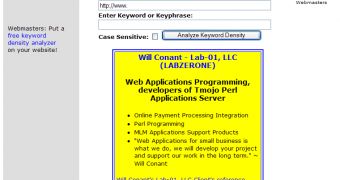The keyword density concept represents a very important factor in SEO (search engine optimization). A keyword is a significant word that refers to a certain content. The keywords are used in the formulation of search queries. As a consequence they should adequately be chosen, used and positioned in the page content in order to obtain a higher place in search listings.
The keyword density is the value of the percentual ratio between the number of times a keyword will occur on a web page and the total number of words present on the same web page and you can calculate it with the next formula:
( NKA / TNW ) x 100 = KDV
where: NKA - number of keyword occurences TNW - total number of page words KDV - keyword density value
It is recommended that the value of keyword density should be kept between the range 2% and 6%. If you keep your keyword density lower than 2%, you could not be visible for search engines when search queries take place. In case the keyword density value is higher than 6%, the search engine spider could treat you as spammer.
The optimal value for keyword density would be in the range 3%-5%. For the text content of a web page, you can calculate the value of keyword density by using a text processor, which will allow you to find the total number of words in the document (TNW) with the word count option. Then, with the help of text processor find or replace function, you will determine the number of the keyword occurence (NKA).
There are also automatic methods of determination for the keyword density, by using a keyword density analyzer. It will permit you to compare various keywords density on the same pages, being able to detect which is the most relevant for your content. I will underline the fact that optimizing the keyword density is not enough for optimizing a site for a higher transparency in search queries or indexing. There are many other factors that influence the search engine optimization process, such as keyword position, type of content, type of page links and more.

 14 DAY TRIAL //
14 DAY TRIAL //